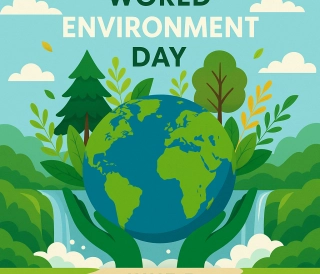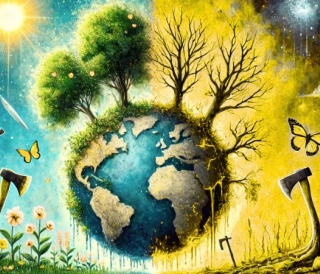Why Must We Conserve Biodiversity?
09-06-2024 19:07
Biodiversity encompasses all species of plants, animals, microorganisms, and the ecosystems in which they exist. It is not merely about the variety of species but also includes the richness of genetic diversity and various ecosystems such as forests, oceans, grasslands, and wetlands. The origins of biodiversity on Earth result from a complex process spanning billions of years. Evolutionary mechanisms such as natural selection, genetic mutations, and biological isolation, combined with geological and climatic changes, have shaped the incredible variety of life we see today. Biodiversity plays an essential role in maintaining ecological processes and provides ecosystem services such as pollination, water quality maintenance, climate regulation, and resources for food and medicine.
Levels of Biodiversity
When discussing biodiversity, the first level to consider is species diversity. Recent estimates suggest that the total number of species on Earth is still largely unknown, but scientists believe there are between 8.7 million and 9 million species.
- Animals: Approximately 7.77 million species, of which about 1 million have been described.
- Plants: Around 298,000 species, including trees, shrubs, grasses, and lower plants like mosses and algae.
- Fungi: About 611,000 species.
- Microorganisms: This group includes bacteria, viruses, and other unicellular organisms. Although challenging to estimate precisely, the number of microbial species could reach millions.
(Source: Global Forest Watch and Our World in Data)
This vast array of biodiversity underpins life on Earth, ensuring the resilience of ecosystems and supporting countless natural and human processes.

Among the Three Levels of Biodiversity, Ecosystems Stand Out
Ecosystems consist of populations, communities, and their interactions with environmental factors. On Earth, there are numerous distinct ecosystems, each contributing to the planet's biodiversity:
- Forest Ecosystems: Include tropical rainforests, temperate forests, boreal forests, and mangroves.
- Freshwater Ecosystems: Encompass rivers, lakes, wetlands, and streams.
- Marine Ecosystems: Cover oceans, seas, and coral reefs.
- Grassland Ecosystems: Include savannas, prairies, and alpine meadows.
- Desert Ecosystems: Feature hot and cold deserts around the globe.
- Mountain Ecosystems: Found in high-altitude regions, characterized by harsh climates and unique biodiversity.
(Source: Nature)
Each of these ecosystems hosts thousands, even millions, of species, ranging from animals and plants to microorganisms. Together, they form a complex and diverse ecological network, sustaining life and maintaining ecological balance on Earth.

Genetic Diversity: The Foundation of Adaptation and Ecosystem Health
Genetic diversity refers to the genetic variation within individuals of a species and between different species. This diversity plays a crucial role in the adaptation and evolution of species, as well as the stability and health of ecosystems.
Adaptation and Evolution
Genetic diversity enables species to adapt to environmental changes, resist diseases, and improve their chances of survival. For instance, in tropical rainforests, trees of various species and genetic variations possess traits such as drought tolerance, frost resistance, and disease resilience. Through natural selection, these traits give rise to dominant varieties that are best suited to the environment.
Ecosystem Stability
Genetic diversity within populations contributes to essential ecological processes, including pollination, nutrient cycling, and the balance of food webs. This ensures the stability and health of ecosystems. A diverse genetic pool provides resilience against environmental fluctuations and supports ecosystem services that are vital for life on Earth.
By preserving genetic diversity, we safeguard the ability of species and ecosystems to endure and thrive in changing environments, securing ecological balance and the sustainability of natural resources.
 Gà rừng - ảnh Tuệ Minh
Gà rừng - ảnh Tuệ Minh
Causes of Biodiversity Loss
Deforestation and Land Use Change
In recent years, global deforestation has reached alarming rates. In 2022 alone, the world lost approximately 4.1 million hectares of primary tropical forests, an area larger than the Netherlands (World Economic Forum). This is part of the estimated 10 million hectares of forest lost annually worldwide (Our World in Data).
In Brazil’s Amazon rainforest, known as the “lungs of the planet,” deforestation remains severe. However, in 2023, efforts by the government and environmental organizations led to a 22% reduction in deforestation compared to the previous year. Despite this progress, an area of 4,775 km² of forest was still destroyed (Mongabay).
Major Causes of Deforestation
-
Agricultural Expansion:
- The expansion of soybean farms and cattle ranches is one of the leading drivers of deforestation. Over 75% of global soybean production is used for livestock feed (Our World in Data).
-
Unsustainable Logging Practices:
- Illegal and unsustainable logging significantly contributes to forest loss, reducing critical habitats and natural resources.
-
Land Conversion:
- Transforming forests into agricultural lands and urban areas destroys habitats for countless plant and animal species.
The loss of forests not only reduces biodiversity but also disrupts ecosystems, accelerates climate change, and diminishes the services that forests provide, such as carbon sequestration and water regulation. Urgent action is needed to address these causes and promote sustainable practices to preserve biodiversity and the health of our planet.

Environmental Pollution
Air Pollution
Industrial activities, transportation, and daily human activities release large amounts of pollutants such as CO2, SO2, NOx, and particulate matter (PM2.5, PM10). Air pollution negatively impacts human health, damages ecosystems, and exacerbates climate change, leading to biodiversity loss.
For example, in New Delhi, India, the average annual PM2.5 levels exceed 90 µg/m³, over 10 times the WHO's safety standard of 10 µg/m³. PM2.5, particles smaller than 2.5 micrometers in diameter, originates from fuel combustion (gasoline, diesel), industrial processes, wildfires, and waste burning. These particles can penetrate deep into the lungs and bloodstream, causing serious health issues such as heart disease, lung problems, and chronic respiratory illnesses (Our World in Data). The WHO now recommends an annual PM2.5 limit of 5 µg/m³ (Global Forest Watch).
Water Pollution
Industrial, agricultural, and domestic waste discharge into freshwater and marine environments causes severe water pollution. This reduces water quality, harms aquatic life, and degrades ecosystems. For instance:
- In the Ganges River (India), chemical and microbial pollution levels often exceed safety thresholds by 100 to 1,000 times (Nature; Mongabay).
- In Europe, approximately 20% of freshwater sources fail to meet safe water quality standards (Our World in Data).
Soil Pollution
Excessive use of chemical fertilizers, pesticides, and industrial waste causes soil contamination. This reduces crop productivity, disrupts soil microorganisms, and degrades soil ecosystems. Examples include:
- In China, around 20% of agricultural land is heavily contaminated by heavy metals and chemicals (Nature).
- In India, more than 60 million hectares of land are polluted and degraded (Our World in Data).
Natural Disasters
Wildfires
Natural and human-induced wildfires have destroyed millions of hectares of forests. For example:
- The "Black Summer" wildfires (2019–2020) in Australia burned over 18 million hectares, killing or displacing 3 billion animals (Mongabay).
- In California (2020), wildfires consumed over 4.2 million hectares (Our World in Data).
Wildfires destroy habitats, kill species, and alter ecosystem structures.
Storms and Flooding
Storms and floods submerge vast areas, destroy habitats, and carry pollutants into ecosystems. Examples include:
- In Bangladesh (2020), floods affected 1.5 million people, severely damaging coastal ecosystems (Nature).
- In the Philippines (2021), Typhoon Rai damaged 5 million hectares of agricultural land and mangrove forests (Mongabay).
Drought
Prolonged droughts result in severe water shortages, killing plants and animals dependent on these ecosystems. Examples include:
- In Africa (2021–2022), extended droughts impacted 20 million people and severely affected desert ecosystems (Our World in Data).
- In California (2021), droughts reduced water levels in reservoirs and rivers to historic lows, affecting freshwater ecosystems and native fish species (Our World in Data).
Impact on Biodiversity
Environmental pollution and natural disasters lead to habitat destruction, population decline, and loss of species. These threats underscore the urgent need for sustainable practices, disaster mitigation, and pollution reduction to preserve biodiversity and ecosystem health.
Overexploitation
Overexploitation of natural resources, including minerals, timber, oil, and other raw materials, on a large and unsustainable scale leads to resource depletion, destruction of natural habitats, and a reduction in species and genetic diversity.
-
Mining and Oil Extraction:
Globally, more than 100 million barrels of oil are produced daily, contributing to pollution and environmental degradation (Our World in Data). Annual global iron ore extraction reaches approximately 2.4 billion tons (Nature). -
Ocean Resources:
Over 34.2% of global commercial fish stocks are being exploited at unsustainable levels (Our World in Data).
The Importance of Biodiversity
Biodiversity is critical for maintaining balance and interaction among Earth's spheres. The loss of biodiversity disrupts life processes and the energy flow between Earth and the universe.
Biodiversity loss is the result of multiple interconnected factors, including deforestation, environmental pollution, natural disasters, and overexploitation. These alarming statistics underscore the severity of the issue and highlight the urgent need for conservation measures and sustainable resource management.
Call to Action
Global efforts must prioritize reducing the root causes of biodiversity loss to safeguard Earth's rich and diverse life forms. This involves implementing sustainable practices, enhancing conservation strategies, and raising awareness about the importance of biodiversity in sustaining life and maintaining planetary balance.
Tuệ Minh
Seeking Climate Justice: Acknowledging Historical Truths
On World Environment Day, Professor Joyeeta Gupta (simulated) offers a powerful lens through which to examine the global climate crisis—one grounded in historical truths and justice. She argues that climate change is not merely a consequence of industrial development or population growth, but the product of a fundamentally unjust and unsustainable development model rooted in colonial legacies.
Balneotherapy: The Natural Art of Water Healing
Balneotherapy, the ancient art of healing through mineral-rich waters, mud, and steam, has stood the test of time—blending centuries-old traditions with modern wellness practices. From easing joint pain to refreshing the mind, it offers a natural path to health that’s both restorative and deeply rooted in nature.
The Green Planet – Plants on Earth
Earth, our "green planet," is the home where life has developed and evolved over billions of years. Within Earth's complex ecosystems, plants play a central role, not only as a source of life for countless species but also as a crucial factor in maintaining planetary balance.
Khe Sanh in March – The Hills Where Coffee Flowers and Fruit Awaken Together
Khe Sanh – Where Nature and Daily Life Flow as One
When March arrives, Khe Sanh awakens in a dazzling display of blossoms and scent.
This land, quiet and humble for most of the year, bursts into color with the pure white bloom of coffee flowers and the vibrant red ripening of jackfruit coffee berries.
It’s not just a season—it’s a living canvas where nature and people breathe in harmony, painting the hills with fragrance, light, and life.






